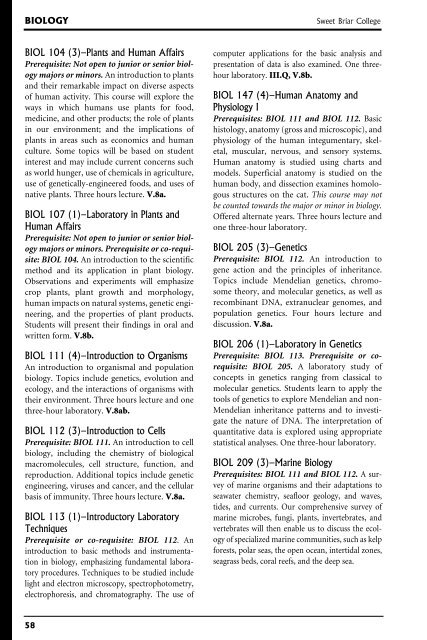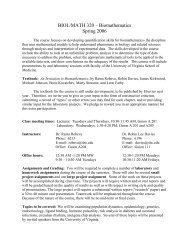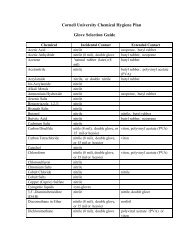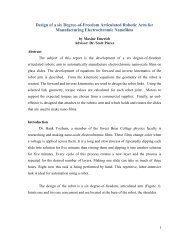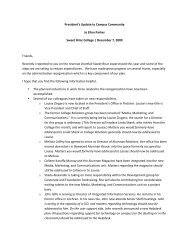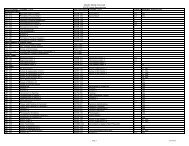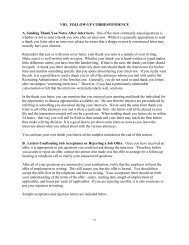Biology<strong>Sweet</strong> <strong>Briar</strong> <strong>College</strong>BIOL 104 (3)–Plants and Human AffairsPrerequisite: Not open to junior or senior biologymajors or minors. An introduction to plantsand their remarkable impact on diverse aspectsof human activity. This course will explore theways in which humans use plants for food,medicine, and other products; the role of plantsin our environment; and the implications ofplants in areas such as economics and humanculture. Some topics will be based on studentinterest and may include current concerns suchas world hunger, use of chemicals in agriculture,use of genetically-engineered foods, and uses ofnative plants. Three hours lecture. V.8a.BIOL 107 (1)–Laboratory in Plants andHuman AffairsPrerequisite: Not open to junior or senior biologymajors or minors. Prerequisite or co-requisite:BIOL 104. An introduction to the scientificmethod and its application in plant biology.Observations and experiments will emphasizecrop plants, plant growth and morphology,human impacts on natural systems, genetic engineering,and the properties of plant products.Students will present their findings in oral andwritten form. V.8b.BIOL 111 (4)–Introduction to OrganismsAn introduction to organismal and populationbiology. Topics include genetics, evolution andecology, and the interactions of organisms withtheir environment. Three hours lecture and onethree-hour laboratory. V.8ab.BIOL 112 (3)–Introduction to CellsPrerequisite: BIOL 111. An introduction to cellbiology, including the chemistry of biologicalmacromolecules, cell structure, function, andreproduction. Additional topics include geneticengineering, viruses and cancer, and the cellularbasis of immunity. Three hours lecture. V.8a.BIOL 113 (1)–Introductory LaboratoryTechniquesPrerequisite or co-requisite: BIOL 112. Anintroduction to basic methods and instrumentationin biology, emphasizing fundamental laboratoryprocedures. Techniques to be studied includelight and electron microscopy, spectrophotometry,electrophoresis, and chromatography. The use ofcomputer applications for the basic analysis andpresentation of data is also examined. One threehourlaboratory. III.Q, V.8b.BIOL 147 (4)–Human Anatomy andPhysiology IPrerequisites: BIOL 111 and BIOL 112. Basichistology, anatomy (gross and microscopic), andphysiology of the human integumentary, skeletal,muscular, nervous, and sensory systems.Human anatomy is studied using charts andmodels. Superficial anatomy is studied on thehuman body, and dissection examines homologousstructures on the cat. This course may notbe counted towards the major or minor in biology.Offered alternate years. Three hours lecture andone three-hour laboratory.BIOL 205 (3)–GeneticsPrerequisite: BIOL 112. An introduction togene action and the principles of inheritance.Topics include Mendelian genetics, chromosometheory, and molecular genetics, as well asrecombinant DNA, extranuclear genomes, andpopulation genetics. Four hours lecture anddiscussion. V.8a.BIOL 206 (1)–Laboratory in GeneticsPrerequisite: BIOL 113. Prerequisite or corequisite:BIOL 205. A laboratory study ofconcepts in genetics ranging from classical tomolecular genetics. Students learn to apply thetools of genetics to explore Mendelian and non-Mendelian inheritance patterns and to investigatethe nature of DNA. The interpretation ofquantitative data is explored using appropriatestatistical analyses. One three-hour laboratory.BIOL 209 (3)–Marine BiologyPrerequisites: BIOL 111 and BIOL 112. A surveyof marine organisms and their adaptations toseawater chemistry, seafloor geology, and waves,tides, and currents. Our comprehensive survey ofmarine microbes, fungi, plants, invertebrates, andvertebrates will then enable us to discuss the ecologyof specialized marine communities, such as kelpforests, polar seas, the open ocean, intertidal zones,seagrass beds, coral reefs, and the deep sea.58
<strong>2010</strong>-<strong>2011</strong> Catalog biologyBIOL 214 (4)–The Plant KingdomPrerequisite: BIOL 104 or BIOL 111. A surveyof the plant kingdom with emphasis on the floweringplants. The structure, reproduction, evolution,adaptations, and economic significance of themajor plant groups will be covered. Three hourslecture and one three-hour laboratory. Offeredalternate years. III.W, V.8ab.BIOL 216 (4)–Insect BiologyPrerequisite: BIOL 111. An introduction toinsects and other terrestrial arthropods, with anemphasis on evolution, morphology, physiology,ecology and behavior. Offered alternate years.BIOL 218 (4)–Field Natural HistoryPrerequisite: BIOL 111, or one course of laboratoryscience and permission. This course willdevelop three important traits of a scientific naturalist:skill at seeing patterns in nature and framinginteresting questions about them; knowledge of thenames, classification, and identifying characteristicsof local organisms; and the understanding of amodern theoretical framework in ecology, evolution,and behavior. Offered alternate years. Threehours lecture and three hours laboratory or fieldwork. V.8a.BIOL 222 (4)–Animal BehaviorPrerequisites: BIOL 111; and one additional3- or 4-credit course in biology, or PSYC 219 orPSYC 231. An introduction to the causes, development,evolution, and function of behavior. Offeredalternate years. Three hours lecture and a one-hourworkshop. May be counted towards the major orminor in either biology or psychology. III.W, V.8a.BIOL 228 (4)–MicrobiologyPrerequisites: BIOL 112, BIOL 113, and BIOL205. Structure, physiology, and ecology of bacteriaand other microorganisms. Three hourslecture and one three-hour laboratory. Offeredalternate years.BIOL 230 (4)–Comparative VertebrateMorphologyPrerequisite: BIOL 111. First-year students bypermission. Functional anatomy of vertebrates,with emphasis on evolutionary adaptations.Three hours lecture and one three-hour laboratory.V.8a.BIOL 247 (4)–Human Anatomy andPhysiology IIPrerequisite: BIOL 147. Basic histology, anatomy(gross and microscopic), and physiology ofthe human cardiovascular, lymphatic, respiratory,digestive, urinary, and reproductive systems.Human anatomy is studied using chartsand models. Superficial anatomy is studiedon the human body, and dissection examineshomologous structures on the cat. Offered alternateyears. Three hours lecture and one threehourlaboratory.BIOL 261 (1, 2, or 3)–Directed StudyPrerequisites: One BIOL course and permissionof the instructor. The study of introductorylevel material by an individual student or bya small group of students under the immediatesupervision of a faculty member.BIOL 301 (4)–Plant EcophysiologyPrerequisites: BIOL 112, BIOL 113; and BIOL104 or BIOL 214. An exploration of how plantsrespond and adapt to their environment. Topicsinclude light responses and photosynthesis,reproduction, dormancy, hormonal regulation,soils and nutrition, plant defenses, and behavior.Students will conduct explorations andexperiments in the laboratory and in campusnatural areas. Three hours lecture and onethree-hour laboratory. Offered alternate years.BIOL 303 (4)–Principles of DevelopmentPrerequisites: BIOL 205 and either BIOL 214,BIOL 218, or BIOL 230. Sophomores by permission.An examination of the processes bywhich a single cell, the fertilized egg, gives riseto a multicellular organism. The modern studyof development relies heavily on the tools andperspectives of cell and molecular biology. Thiscourse will integrate these new methods andapproaches with those of classical embryologyin the study of several model organisms. Offeredalternate years. III.O, V.8a.BIOL 310 (4)–EvolutionPrerequisites: BIOL 205 and one additional200-level biology course. Sophomores bypermission. A good grasp of algebra will beassumed. As the unifying principle of all biology,evolution overlaps genetics, molecular biol-59
- Page 1:
S w e e t B r i a r CollegeCatalog
- Page 6:
A Brief HistorySweet Briar Collegei
- Page 14 and 15: academic scholarshipsVirginia resid
- Page 17 and 18: 2010-2011 Catalog student lifephysi
- Page 19 and 20: 2010-2011 Catalog student lifeColle
- Page 21 and 22: 2010-2011 Catalog college feesThis
- Page 24 and 25: general policiesSweet Briar College
- Page 26 and 27: general policiesSweet Briar College
- Page 28 and 29: academic programsSweet Briar Colleg
- Page 30 and 31: academic programsSweet Briar Colleg
- Page 32 and 33: academic programsSweet Briar Colleg
- Page 34 and 35: academic programsSweet Briar Colleg
- Page 36 and 37: academic regulationsAcademicRegulat
- Page 38 and 39: academic regulationsSweet Briar Col
- Page 40 and 41: equirements for the degreeSweet Bri
- Page 42 and 43: equirements for the degreeSweet Bri
- Page 44 and 45: equirements for the degreeSweet Bri
- Page 46 and 47: equirements for the degreeSweet Bri
- Page 48 and 49: Courses of instructionSweet Briar C
- Page 50 and 51: Anthropology and ArchaeologySweet B
- Page 52 and 53: Anthropology and ArchaeologySweet B
- Page 54 and 55: Anthropology and ArchaeologySweet B
- Page 56 and 57: arts ManagementSweet Briar CollegeA
- Page 58 and 59: BiologyBiologyModern biology has ev
- Page 62 and 63: iologySweet Briar Collegeogy, anato
- Page 64 and 65: BusinessBusinessThe mission of the
- Page 66 and 67: BusinessSweet Briar Collegefunction
- Page 68 and 69: BusinessSweet Briar Collegeincludin
- Page 70 and 71: ChemistrySweet Briar Collegelaborat
- Page 72 and 73: chemistrySweet Briar CollegeCourse
- Page 74 and 75: chemistrySweet Briar CollegeCHEM 33
- Page 76 and 77: classics, philosophy, and religionS
- Page 78 and 79: classics, philosophy, and religionS
- Page 80 and 81: classics, philosophy, and religionS
- Page 82 and 83: classics, philosophy, and religionS
- Page 84 and 85: classics, philosophy, and religionS
- Page 86 and 87: classics, philosophy, and religionS
- Page 88 and 89: economicsSweet Briar CollegeECON 10
- Page 90 and 91: educationSweet Briar CollegeThrough
- Page 92 and 93: educationSweet Briar CollegeEDUC 22
- Page 94 and 95: englishSweet Briar Collegeable outc
- Page 96 and 97: englishSweet Briar Collegeare encou
- Page 98 and 99: englishSweet Briar CollegeStudents
- Page 100 and 101: englishSweet Briar CollegeENGL 110
- Page 102 and 103: englishSweet Briar CollegeENGL 218
- Page 104 and 105: englishSweet Briar Collegesized. Pl
- Page 106 and 107: EnglishSweet Briar CollegeENGL 397
- Page 108 and 109: EnglishSweet Briar Collegeand op-ed
- Page 110 and 111:
environmental studiesSweet Briar Co
- Page 112 and 113:
environmental studiesSweet Briar Co
- Page 114 and 115:
equine studiesSweet Briar CollegeEN
- Page 116 and 117:
gender studiesSweet Briar Collegeas
- Page 118 and 119:
government and international affair
- Page 120 and 121:
government and international affair
- Page 122 and 123:
government and international affair
- Page 124 and 125:
historySweet Briar Collegewhich cou
- Page 126 and 127:
historySweet Briar CollegeHIST 144
- Page 128 and 129:
historySweet Briar CollegeHIST 272
- Page 130 and 131:
HistorySweet Briar Collegears, and
- Page 132 and 133:
History of artSweet Briar Collegeth
- Page 134 and 135:
History of artart theory in the 15t
- Page 136 and 137:
honors programSweet Briar Collegeon
- Page 138 and 139:
Interdisciplinary studiesSweet Bria
- Page 140 and 141:
latin American studiesSweet Briar C
- Page 142 and 143:
law and societySweet Briar CollegeC
- Page 144 and 145:
Mathematical and computer sciencesS
- Page 146 and 147:
Mathematical and computer sciencesS
- Page 148 and 149:
mathematical economicsSweet Briar C
- Page 150 and 151:
modern languages and literaturesSwe
- Page 152 and 153:
modern languages and literaturesSwe
- Page 154 and 155:
modern languages and literaturesSwe
- Page 156 and 157:
modern languages and literaturesSwe
- Page 158 and 159:
modern languages and literaturesSwe
- Page 160 and 161:
modern languages and literaturesSwe
- Page 162 and 163:
modern languages and literaturesSwe
- Page 164 and 165:
musicSweet Briar CollegeCourse Desc
- Page 166 and 167:
musicSweet Briar CollegeMUSC 245 (1
- Page 168 and 169:
physical education, athletics, and
- Page 170 and 171:
physical education, athletics, and
- Page 172 and 173:
physics and engineeringSweet Briar
- Page 174 and 175:
physics and engineeringSweet Briar
- Page 176 and 177:
physics and engineeringSweet Briar
- Page 178 and 179:
physics and engineeringSweet Briar
- Page 180 and 181:
psychologySweet Briar CollegeThe Ps
- Page 182 and 183:
psychologySweet Briar CollegePSYC 3
- Page 184 and 185:
iding programReligionSee the Depart
- Page 186 and 187:
iding programSweet Briar CollegeRDP
- Page 188 and 189:
sociologySweet Briar CollegeNote: F
- Page 190 and 191:
sociologySOCI 450 (3)-Sociological
- Page 192 and 193:
studio artSweet Briar CollegeARTS 1
- Page 194 and 195:
studio artSweet Briar Collegetorica
- Page 196 and 197:
theatre and danceSweet Briar Colleg
- Page 198 and 199:
theatre and danceSweet Briar Colleg
- Page 200 and 201:
theatre and danceSweet Briar Colleg
- Page 202 and 203:
theatre and danceSweet Briar Colleg
- Page 204 and 205:
Academic honorsSweet Briar Collegeo
- Page 206 and 207:
Academic HonorsSweet Briar CollegeT
- Page 208 and 209:
facultySweet Briar CollegeGraduate
- Page 210 and 211:
FacultySweet Briar CollegeLinda S.
- Page 212 and 213:
FacultySweet Briar CollegeRebecca M
- Page 214 and 215:
FacultySweet Briar CollegeEmeritiGr
- Page 216 and 217:
Board of DirectorsSally Old Kitchin
- Page 218 and 219:
AdministrationSweet Briar CollegeOf
- Page 220 and 221:
indexSweet Briar CollegeFFaculty, 2
- Page 222 and 223:
Communications with the CollegeAdmi


